Understanding "Sell Through" with Publishers' Assistant

By Ron Lawrence
August, 2005
I've just returned from the PMA University conference in New York, and got a great education on what publishers are focused on to manage their businesses. I'm feeling great about how Publishers' Assistant meets those needs. In several sessions at the conference, Dominique Raccah of Sourcebooks, Inc. promoted a concept she called "Sell Through." In this article, I'll explore our interpretation of Dominique's presentation and how Publishers' Assistant can help you get your arms around this important concept for your own titles.
In general, the concept of "Sell Through" refers to the management of inventory by being aware of the returns you are likely to experience throughout the life of your title. The major objective in understanding Sell Through is to minimize the unsold inventory at the end of the books sales life.
Dominique has shrewdly focused on understanding the performance of her major customers by measuring how many books they return in relation to their purchases. Imagine you receive an order for 200 copies of one of your titles from a major book handler who we will call the "Enormous Book Company." As exciting as it is to have Enormous Book Company order another 200 books, Dominique has recognized that she's likely to get some percentage of those copies back as returns. That results in a loss for shipping and often damaged books. If the order comes late in the title's sales life, understanding how many copies you are likely to get back becomes critical.
The problem is worse if your inventory is low. The temptation will be to order another print run. Dominique professes that "Your last print run is your most expensive." That's because some percentage of those books will never sell. If a significant number of those books wind up back on your shelves as returns, you could easily realize a financial loss on the print run. Dominique uses another catch phrase to drive home the Sell Through management concept: "Shipping less to make more!"
Shipping less to make more?
The idea is that if you understand how many books you truly have in the system, then you can make better decisions about whether and when to ship books to your major buyers. "How many books you have in the system" is not just your on-hand inventory. It's also more than what may still be located at the buyer's location. The number includes a percentage of what you are likely to see as returns at this point in the title's life cycle. Here's where Publishers' Assistant can help.
How many books do I have on hand?
Inventory Status Report
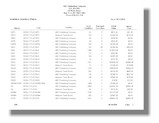 Publishers' Assistant has several Inventory Status reports which will tell you how much inventory you have and in which locations or warehouses. One thing to keep in mind is that the Publishers' Assistant inventory system is date sensitive. So not only can you tell what you have in stock now, but you can look back in time to see what you had in stock on any given date. That may be important when you begin to analyze Enormous Book Company's performance with other books in your history.
Publishers' Assistant has several Inventory Status reports which will tell you how much inventory you have and in which locations or warehouses. One thing to keep in mind is that the Publishers' Assistant inventory system is date sensitive. So not only can you tell what you have in stock now, but you can look back in time to see what you had in stock on any given date. That may be important when you begin to analyze Enormous Book Company's performance with other books in your history.
Note: There are several sample reports cited in this article — each is represented by an icon on the left of the page. Click on the icon to see a PDF version of the sample report. Use the "Back" button on your browser to return to the article.
How many copies are located at Enormous Book Company?
Consignment Inventory Status Report
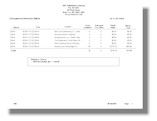 How you get a handle on this depends on your relationship with Enormous Book Company. If you ship them books on consignment, then the "Consignment Inventory Status" report will help. It reports the quantity of each of your titles at each consignment location. You can limit the report to a specific title to get a good picture of where that title is located. If you ship to multiple locations for your buyer, they will all show up in the "Consignment Inventory Status" report.
How you get a handle on this depends on your relationship with Enormous Book Company. If you ship them books on consignment, then the "Consignment Inventory Status" report will help. It reports the quantity of each of your titles at each consignment location. You can limit the report to a specific title to get a good picture of where that title is located. If you ship to multiple locations for your buyer, they will all show up in the "Consignment Inventory Status" report.
If, instead, you treat Enormous Book Company as a warehouse, you'll see your inventory in the "Inventory Status" report. Publishers' Assistant 4.3 will allow you to invoice directly out of their warehouse.
If you simply sell your books to Enormous Book Company outright, you may have less visibility into how many they currently have in stock; but you'll still gain more perspective on this when looking at their sales vs. returns performance in the next section.
How many returns should I expect from Enormous Book Company?
There are a couple of ways to look at this. You can look at your buyer's recent sales and returns history for the title in question. But you can also look at their performance for other titles. If you are particularly savvy about this, you can look at Enormous Book Company's sales vs. returns for other titles at a similar period in their life cycle to your current book. To get the full picture, you may want to see what you and your buyer had in stock during that time period. This is where Publishers' Assistant's date-sensitive inventory system comes in handy.
Publishers' Assistant actually features a number of Sales vs. Returns reports. In the interest of giving credit where credit is due, we would like to thank some of our users who have requested these reports and aided in their specification:
- Laura Rust of Scholarly Books
- Tom Doherty of Cardinal Publishers Group
- Arnold Smoller of Book Clearing House
All of the Sales vs. Returns reports appear on the Sales Reports menu. Here's a partial list:
Sales vs. Returns
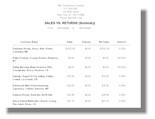 The "Sales vs. Returns" report shows you returns as a percentage of sales for each customer. The detail version of this report will list the individual invoices and returns. You may notice in these reports that it's possible to have returns outrun your sales for the period being reported.
The "Sales vs. Returns" report shows you returns as a percentage of sales for each customer. The detail version of this report will list the individual invoices and returns. You may notice in these reports that it's possible to have returns outrun your sales for the period being reported.
Sales vs. Returns Descending
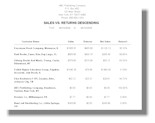 You can quickly gain some perspective about the relative performance of your customers by looking at the "Sales vs. Returns Descending" report. This report sorts your customers by the amount of returns (in dollars) in descending order. So, the customers that return the most will appear at the top of the report. In this sample report, the Enormous Book Company is at the top of our list!
You can quickly gain some perspective about the relative performance of your customers by looking at the "Sales vs. Returns Descending" report. This report sorts your customers by the amount of returns (in dollars) in descending order. So, the customers that return the most will appear at the top of the report. In this sample report, the Enormous Book Company is at the top of our list!
Which titles are Enormous Book Company ordering and then returning?
Sales vs. Returns by Title by Customer
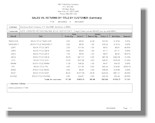 The "Sales vs. Returns by Title by Customer" shows the titles ordered and returned in detail. That gives you a pretty good picture of how the buyer is doing with each of your titles, as well as how one title compares with another.
The "Sales vs. Returns by Title by Customer" shows the titles ordered and returned in detail. That gives you a pretty good picture of how the buyer is doing with each of your titles, as well as how one title compares with another.
One thing to look for is whether a particular title is being ordered and returned in the same period. Some of the major book buyers have multiple locations. One location may not know that the book they need is slated to be returned from another location.
On this point, Steve Carlson of Upper Access Publishing offers that "'Enormous' wholesalers and chains never put back into stock the returns they receive from bookstores. They simply ship them back to the publishers, even on the same day as ordering more."
Sales History for a Title
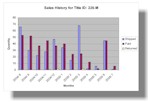 While writing this article, I was curious to see what the life span of a title looked like visually. So, I exported data from Publishers' Assistant to graph it using Microsoft Excel. Click on the icon at the left to view the Excel document that was generated.
While writing this article, I was curious to see what the life span of a title looked like visually. So, I exported data from Publishers' Assistant to graph it using Microsoft Excel. Click on the icon at the left to view the Excel document that was generated.
You can see that I've broken down the quantities that were shipped and returned, as well as the quantity that was paid for each month for the reporting period. The result is that you can not only see the shipments and returns performance; but you can also see the delay in payment for those books.
My curiosity led me to figure out how to automatically generate this graph from within Publishers' Assistant. Consequently, our users will have another exciting new feature to look forward to in our upcoming release!
Note: The graph I have produced is for the same one-year span I have used in the other reports. However, the curve over the life-span of the title becomes much more obvious if I graph a longer period (two or three years). On the other hand, the bars on the graph become so thin that it becomes difficult to read. So, I opted for consistency with the other reports I've included.
So, should I ship this order to Enormous Book Company?
If your history shows that you can expect a significant number of returns at this point in a book's life, then you may want to apply the brakes. If your own inventory is low, then you'll really want to be on top of how many books you have out in the market. We heard several times during the convention that even books that have been paid for can be returned.
Knowing the numbers is one thing; but managing the situation is another. A strategy that Dominique seems to use is to work with her customers to help them understand their own purchasing history. Again, Steve Carlson offers that "You should probably discuss with your buyer at Enormous Book Company the reduced quantity that you are shipping, and the reasons. If you can show that you have crunched numbers and are reasonably predicting that Enormous Book Company's need will be met with a smaller shipment, their buyer will usually be happy to accept the smaller shipment."
Having good data and presenting it in an easy-to-understand format is the key. And that's exactly where Publishers' Assistant can help.





 Follow conversations with Ron on SPANNet.org.
Follow conversations with Ron on SPANNet.org.
 Proud participant in Microsoft Visual FoxPro Forum at Tek-Tips
Proud participant in Microsoft Visual FoxPro Forum at Tek-Tips